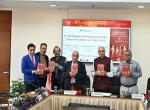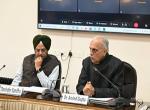A programme on the current status of Left Wing Extremism (LWE) movement in India, based on the book “Naxalite Movement of India”, authored by Shri Prakash Singh, noted expert on internal security, former DG BSF and former DG Uttar Pradesh, was organised at the Vivekananda International Foundation, New Delhi on July 11, 2018.
The programme was chaired by Dr Arvind Gupta, Director VIF, who introduced the author and outlined the detailed chronology of the growth of LWE movement in India, starting from Naxalbari village in West Bengal in the mid-1960s to its peak over the last 50 years plus, spreading across 123 districts and 20 states of the country. Dr. Gupta noted that in the recent years the movement has suffered serious setback due to sustained operations of the local police and the CRPF detachments deployed in the affected areas. He also noted the positive impact of improved connectivity and well-coordinated intelligence backed operations of the security forces.
Shri Prakash Singh, in his address, traced the historical genesis of the LWE movements, his personal interactions with the Maoist leaders, the growth of the LWE movement and its having acquired a degree of legitimacy amongst the poor, disadvantaged and exploited sections on the masses. He classified the LWE movement into three phases:-
Phase 1 – Early formative years of CPI;
Phase 2 – Relative decline and revival in late 1980s;
Phase 3 - Militarisation of LWE Movement with merger MCCI and PWG in 2004.
Shri Singh particularly drew attention to the brazen nature of attacks undertaken by the LWE cadre on CAPFs and government establishments after acquiring high level of militarisation, access to sophisticated weapons, posing significant threat to the internal security of India. While deliberating certain preventive measures, a review of developmental measures implemented by successive government and its relative impact were also highlighted.
Shri Singh and fellow discussants, Lt. Gen. (Retd) Ahluwalia and Dr. Rammana of IDSA, in their presentations/comments pointed out that:-
- The violence in LWE affected areas has been contained thorough security operations to about 90 districts spanning 10 states. Out of these 90 districts, 30 are still categorised as acutely affected;
- Government of India’s multipronged strategy consisting of security measures, developmental interventions and ensuring rights and entitlements of the local communities is making an impact in the LWE affected states;
- The development initiatives have resulted in larger number of LWE cadres surrendering to the security forces, and shrinking credibly the mass based appeal of LWE movement;
- These measures, particularly the successful implementation of projects, has made it difficult for the LWE local level leadership to rope-in fresh recruits by highlighting the key issues pertaining to Jal (water), Jamin (land) and Jungle (forest).
In their summing up remarks, Shri Prakash Singh, panellists, discussant’s and Director VIF, Dr. Gupta, reiterated the need for sustained proactive kinetic pressure on the activists by further strengthening counter-insurgency capabilities of the Central and State forces; providing them equipment, specialised training, ensuring flow of actionable intelligence and coordinated operational centres. They acknowledged that the area of influence of LWE movement had significantly shrunk since its peak in 2010; level of violence had come down, significant number of leaders have been arrested or neutralised. However, the discussants pointed out that twice in the past, similar trends were noticed but the movement managed to bounce back with greater degree of militarisation. This has to be guarded against by addressing the core issues of economic inequality, illiteracy, acute poverty, inefficiency and corruption at the lower levels in implementation of projects, slow pace of land distribution, absence of performance audit, etc









Post new comment